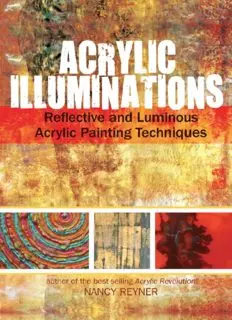
Acrylic Illuminations. Reflective and Luminous Acrylic Painting Techniques PDF
Preview Acrylic Illuminations. Reflective and Luminous Acrylic Painting Techniques
Acrylic Illuminations Reflective and Luminous Acrylic Painting Techniques Nancy Reyner Cincinnati, OH artistsnetwork.com Thank you for purchasing this Artist Network eBook. Sign up for our newsletter and receive special offers, access to free content, and information on the latest new releases and must-have art resources! Plus, receive a coupon code to use on your first purchase from NorthLightShop.com for signing up. or visit us online to sign up at http://artistsnetwork.com/ebook-promo Contents Special Offers Introduction About This Book Crash Course on Acrylic Your Acrylic Toolbox Pigment/Color Acrylic Binders: Mediums, Gels and Pastes Inventing With Your Toolbox Application Tips and Materials Distinctive Metallics Essential Tips for Metallics Basic application of gold leaf Mixing Metal Leaf Textured Metal Sanding Metal Leaf High Gloss Leaf Gold Leaf Backgrounds Intensify Metallic Hues Decorative Designs Subtractive Glazing Tarnish Effects Faux Leaf Patinas Drawing on Leaf Glitter and Metal Flakes Metal Paint Prismatic Effects Essential Tips for Reflective Paints Multicolor Imprint Veiling Layers with Pastes Matte Skins Construction Soft Melted Effects Multiple Layering Fake Wax Underglow Effects Overglow Sheens Prismatic Layering Embedded Pearlized Color Secret Tricks to Pouring Essential Tips for Pouring Surfboard Finish Dirty-Mix Pours The Supreme Pour Smoothing Pours Poured Glazing Deep Pouring Embedding Objects Pouring Veiled Effects Halo Staining Metallic Rainbow Color Field Staining Marbleizing Color Fields Shaped Edge Washes Hard and Soft Edge Pouring Optical & Luminous Effects Essential Tips for Optical and Luminous Effects The Paint as Itself Polished “Stone” Effects Sheen Shifting Subtractive Metallic Grisaille Metallic Drawing Surfaces Stained Glass Effect Veiling Metal Leaf Glass Refraction Pouring Embedded Leaf Fluorescent and Phosphorescent Paints Vibrating Optical Effects High Contrast Contributing Artists About the Author Dedication Acknowledgments Copyright Introduction About This Book Art enhances our lives. Whether we view it for pleasure or create it as artists, art can serve us in ways both private and public. Making art just for ourselves is similar to writing in a diary: the writing is personal and not meant to be read by others, eliminating the need for editing. On the other hand, artists intending to communicate through their work to others will first need to grab someone’s attention with the work visually. Getting attention has more up its sleeve than loud colors or provocative imagery. This book offers fifty ways to “catch the eye.” The range of techniques swing from subtle glazing on metal leaf, to pearly sheens of exotic beetle wings, as well as boldly colored optical effects. Similar to my previous books, Acrylic Revolution and Acrylic Innovation, Acrylic Illuminations is a recipe book of techniques, meant to be used like you would a cookbook for a dinner party. Start by selecting what inspires you and vary the ingredients to your liking. Incorporate them into your current process or allow them to move your work in a new direction. All of my books, like my teaching, are created with the intent to offer ways of inventing, not copying. Step-by-step instruction allows mastery of a technique. It is up to the reader to transform the technique into a finished painting of his or her choice. Some techniques just by themselves can produce a complete painting. Often, however, working further than the technique dictates will push the work from a singular technique into a more satisfying painting. Use the techniques for personal or professional work, for abstract or realistic styles, as backgrounds, top layers or for accents layered in between. Try combining several techniques in one painting by layering each technique separately (see Technique 19 for multiple technique layering). The instructions are not set in stone, but meant to inspire you to change them, encouraging our wonderful innate sense of play. I’d also like to emphasize that techniques are not styles. This means that every technique in this book can be used to create a representational or abstract image in any style. I have purposely varied the artwork examples as reminders, hopefully dispelling a myth that working in acrylic also means that the work must be abstract. As an example, the pouring technique in Technique 26 can be used to create some interesting organic and abstract forms, yet can also create beautiful landscape elements and backgrounds for still life and portraits. Each technique is demonstrated with concise illustrated steps and finished painting examples. A bonus chapter, Crash Course on Acrylic, opens the book and offers an overview on how to use acrylic paints and products to their fullest potential. This first chapter has great tips to guide you through any technique you choose with greater ease. Please read this section, as even experts can benefit. Terms are defined, while general tips and information that pertain to techniques are explained, allowing a fuller understanding of the technical process. This chapter adds multiple ways to individualize techniques by expanding and varying them to your preferences. The remaining four chapters contain fifty techniques, grouped together by particular materials or visual effects. Specific tips for those techniques are included in the first two pages of each chapter. These tip pages are vital to obtain best results. Please read these as they can save you both time and money. Best wishes for inspiration, new ideas and eye-catching results!
